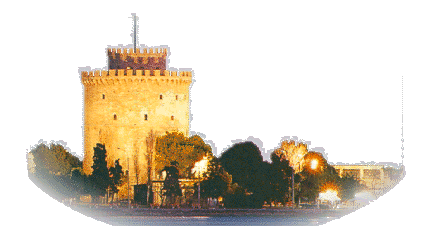
.
THESSALONIKI
the bride of Thermaikos

Thessaloniki, the second largest city in GREECE with a population of 1,000,000 inhabitants, is one of
the oldest cities in Europe. It stretches over twelve kilometers
in a bowl formed by low hills facing a bay that opens into the
Gulf Thermaikos. It was founded about 315 B.C., on a site
of old prehistoric settlements going back to 2300 B.C., by
Cassander, King of Macedonia, and was named after his wife,
Thessaloniki, sister of Alexander The Great. Since then,
Thessaloniki has become the chief city of Macedonia and its most
important commercial port. In Roman times it was visited by Saint
Paul, who preached the new religion, and who later addressed
his two well-known epistles (the oldest written documents of
Christian literature) to the Christians of Thessaloniki.
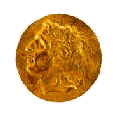
The Byzantine times
In Byzantine times, Thessaloniki became a cultural and artistic
centre second only to Constantinople in the whole empire.
Great names are closely associated with the city's Byzantine past
- the jurist Peter Magister, the epigrammatist Macedonius
Hypatus, the Hymnographer Archbishop Joseph, Leo the
Mathematician, the historian John Cameniates, the prolific
Homeric scholar and humanist Eustathius ( Archbishop of
Thessaloniki), the philologist Thomas M. Magister, the teacher of
law and editor of the "Hexabiblus" Constantine
Armenopoulos, the theologian Gregory Palamas ( Archbishop of
Thessaloniki), to mention but a few prominent scholars. The
missionary brothers Cyril and Methodius also have a
special place in the history of the period; they invented and
used the Cyrillic Alphabet to bring literacy and Christianity to
the Slavs.

Cultural contribution
After the fall of Thessaloniki (1430) and later of Constantinople
(1453), the two major cultural centres of the East, two of
Thessaloniki's greatest humanists, Theodore Gazes and
Andronicus Callistus, sought refuge in the West where they
transplanted the Greek language and literature. Despite the
unfavourable conditions prevailing during the Turkish occupation,
there were Greek schools in Thessaloniki that struggled,
successfully to a large degree, to preserve the Greek language
and literature until the city was liberated in October 26, 1912,
the anniversary of its patron saint, St. Demetrius. In the
nineteenth century the long scholarly tradition of the city was
continued by Margaritis Demetsas, a historian, archeologist, and
geographer as well as headmaster of the city Grammar School and
his pupil P. Papageorgiou, later a prominent philologist.
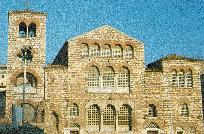
Monuments
Among the numerous monuments of particular interest in the city
are those from the Roman period, the Triumphal Arch of
Galerius and the Rotonda. Thessaloniki is, however,
above all famous for its Byzantine period, being second only to
Constantinople itself. Its many churches whose fine mosaics and
wall-paintings are representative of various periods of Byzantine
art have survive to enhance the image of the city. They include St.
Demetrius, Panagia Acheiropoietus, the Holy Apostles, St.
Sophia, St. Catherine, Panagia Chalkeon, St. Nicholas the Orphan,
the Prophet Elijah, and the Monastery of Vlatadon. Large sections
of the city-walls are also still standing, together with one of
their main bastions, the well-known White Tower.
Noteworthy from a national, spiritual and artistic viewpoint are
also the continuing strong links between the the city of
Thessaloniki and Mt. Athos.
Modern Architecture
The modern era of material and cultural development in
Thessaloniki dates from its liberation in 1912, when Thessaloniki
became the capital city of Northern Greece. The Ministry of
Northern Greece, the Cathedral, the Court of Justice, in addition
to other major government institutions, are situated today in the
city. The town has today two quite distinct sectors: The
"old town", continuously undergoing reconstruction, and
the modern sector, whose many modern buildings are examples of
advanced architecture.
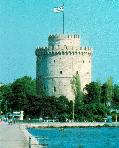
Cultural life
In addition to the University, there are numerous institutions
that contribute to the academic and cultural life of the city.
Among them are the Macedonian University, The Archeological and
Byzantine museums, the Folklore museum, the State Conservatory,
Theatres and Orchestras, the Society of Macedonian Studies, the
Institute for Balkan Studies, and other cultural and artistic
organisations.
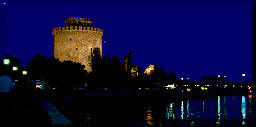
Today
Today Thessaloniki is a thriving city and one of the most
important trade and communications centres in the Mediterranean.
This is evident from its financial and commercial activities, its
port with its special Free Zone, which provides facilities to the
other Balkan countries, its international airport, its important
industrial complex, its annual International Trade Fair, etc.
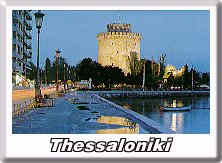
THESSALONIKI OLD TOWN PHOTO GALLERY
[THESSALONIKI from SPACE] -[THESSALONIKI on EARTH]
![]() VACATION IN GREECE
VACATION IN GREECE![]() A complete tourist guite
of Greece....Is fantastic!!!!
A complete tourist guite
of Greece....Is fantastic!!!!